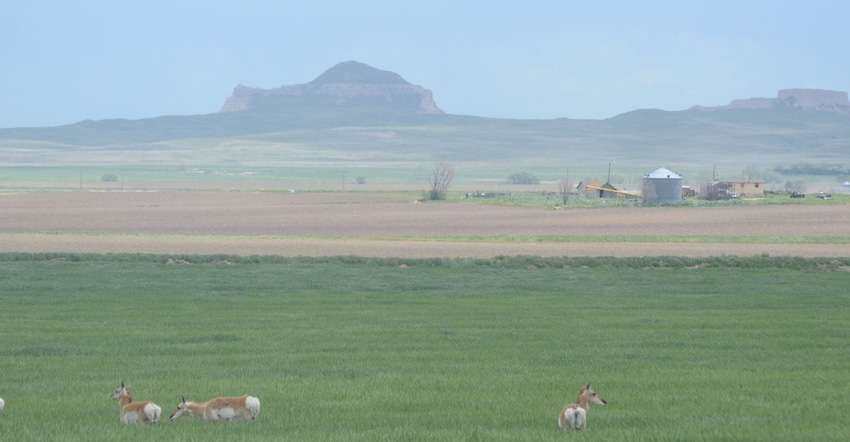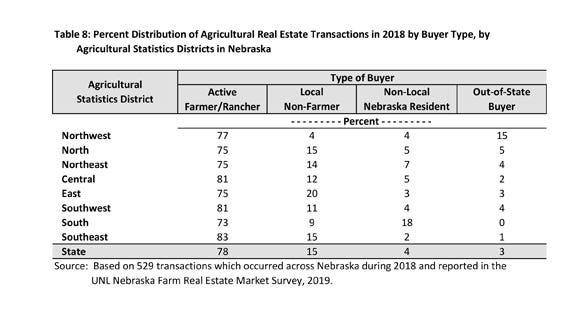
The University of Nebraska-Lincoln's Department of Agricultural Economics recently released its 2018-19 Nebraska Farm Real Estate Report, offering insight into how the ag land market and cash rents have changed over the past year.
However, the report also provides a glimpse into characteristics of land market transactions, using a sample set of 529 representative market sales that took place across the state in 2018.
One of the highlights from this portion of the report shows that of the types of financing associated with ag land sales in 2018, cash purchases rose from 50% in 2017 to 53% in 2018, while mortgages declined from 48% to 43%. Contract for deed and the "other" category make up 2% each.
"Is that shift significant? When you look back over the last several years, contract for deed is low, but cash sales and mortgages or loans tend to stay around half of the purchases each," says Jim Jansen, Nebraska Extension ag economist and one of the authors of the report. “This year, it’s about 53% cash sales versus 43% mortgages.
“If you look in the greater Southeast, East and Northeast districts, we tend to see numbers around 50%. The one that sticks out is the Southwest District, where we see a considerably higher rate of mortgages compared to cash sales."
Indeed, mortgages made up 85% of land sales in the Southwest District, compared to cash sales with only 11%. The reason isn't clear, however.
What is clear is that even with the average age of the farmer and rancher increasing, active farm or ranch operators still make up the majority, 78%, of parties who purchased ag real estate across Nebraska. Nonfarmer local buyers make up the second-largest category at 15%, with nonlocal Nebraska residents making up 4%.
"Local control still appears to be one of the top trending buyers, whether it's an active farmer or rancher or local nonfarmer,” Jansen says. “When you look at the summary statistics for the state, greater than 97% is still being purchased by individuals inside the state of Nebraska. If you look at non-Nebraska residents, out-of-state buyers still have a very small portion, around 3% of the transactions reported were by individuals who were out-of-state buyers."

Estate sales also made up the highest percentage of land sellers in 2018 at 39%. Active farmers made up the second highest at 26%, followed by local nonfarmers at 15%. Meanwhile those quitting farming made up only 6%.
"Local nonfarmers might be people that own land they've inherited [absentee landowner] and choose to sell it for various reasons," Jansen says. "It appears the highest percentage of land being sold is coming out of those who were once operators but are at a stage of life after passing that the estate eventually sells the land."
The Northwest District and the North District (which includes most of the north-central Sandhills) had the largest average parcel sizes — at 686 acres and 1,274 acres, respectively. These districts also saw some of the lowest prices per acre, at $841 and $1,053, respectively.
The North District saw the largest increase in the percentage of land sold by type, and the largest decrease. In 2018, 20% of the land sold in the district was irrigated cropland, compared with 3% in 2017. Meanwhile, 77% of the land sold in the district was dryland pasture, compared with 94% in 2017.
However, as Jansen notes, pasture sales still make up most land sales in the north and northwest, which is why the average parcel size tends to be bigger.
These western regions also saw more out-of-state buyers.
For most individual districts, out-of-state buyers made up 5% or less of land sales, with the exception of the Northwest District, which includes the entire Nebraska Panhandle.
"When you look at the geographic layout of the Northwest District, the region has characteristics that may be more desirable or conducive for outdoor recreational activities, whether it's hunting, camping or fishing," Jansen explains. "You might be looking to metro areas to the southwest. Denver may be a market where out-of-state buyers might be coming from."
About the Author(s)
You May Also Like






